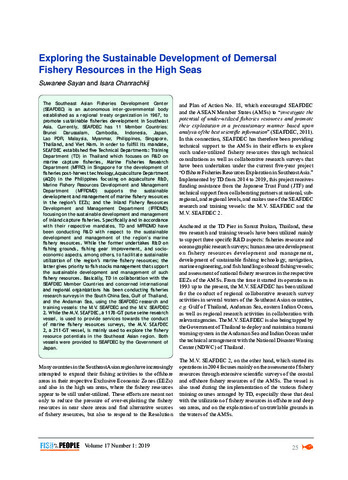| dc.coverage.spatial | Southeast Asia | en |
| dc.date.accessioned | 2019-07-01T08:49:46Z | |
| dc.date.available | 2019-07-01T08:49:46Z | |
| dc.date.issued | 2009 | |
| dc.identifier.citation | SEAFDEC. (2009). Report of the regional study on sea cucumber fisheries, utilization, and trade in Southeast Asia, 2007-2008. Bangkok, Thailand: Secretariat, Southeast Asian Fisheries Development Center. | en |
| dc.identifier.uri | http://hdl.handle.net/20.500.12066/4922 | |
| dc.description.abstract | The present trend towards overfishing of sea cucumbers in diverse geographical areas to supply international market demand has become an urgent concern in the international community. There is also an attempt to conserve and manage sea cucumber in commercial species by various international organizations. Nonetheless, inadequate attention is given to the management of these species since its fisheries status is not very well known. The ASEAN-SEAFDEC Member Countries therefore agreed to conduct the ‘Regional Study on Sea Cucumber Fisheries, Utilization, and Trade’ and established the ‘Ad-hoc Regional Working Group on Sea Cucumbers Fisheries’ in July 2007. Outcomes of the Regional Study show that more than 135 species of sea cucumber were found in Southeast Asia during the desk study. Sea cucumbers are generally harvested by local fishermen using simple or traditional methods. Sea cucumbers are mostly utilized for both local consumption and export market particularly the Chinese market. Sea cucumbers are sold in various forms, e.g. fresh, dried, and advanced processed products for consumption as culinary delicacies as well as medical and nutritional products. However, data and information related to trade in sea cucumbers may have been underestimated and/or overestimated at national levels due to various reasons, i.e. it is the target species, having high demand for export, could be traded at border-to-border, etc. There are a number of common problems in data and information collection including statistical records do not reflect the actual sea cucumber fisheries; existing research capacity limit the appropriate data collection including biological data, resource status, its habitat, trade status and fisheries; existing taxonomical knowledge limit the appropriate identification of sea cucumber species; and lack of trained staff. These identified problem areas should be strengthened. Sea cucumbers clearly represent an economically important fisheries resource and alternative livelihoods for local communities in the ASEAN region, therefore listing of sea cucumbers under any Convention of International Trade in Endangered Species (CITES) appendices should not be made without best scientific information. Instead, there should be management measures of sea cucumbers in place in an effective and efficient manner. In doing so, it should be accommodated into a national fisheries management framework where exists. In addition, enhancement of commercial stock should be promoted through the development of aquaculture techniques and restocking program. Each Member Country should recognize and distinguish the economically important species and identify ways for the stock enhancement program of such species. | en |
| dc.format.extent | v, 130 p. : ill. (some col.), col. maps ; 30 cm. | en |
| dc.language.iso | en | en |
| dc.publisher | Secretariat, Southeast Asian Fisheries Development Center | en |
| dc.subject | South East Asia | en |
| dc.subject.lcc | Trepang fisheries -- Southeast Asia | en |
| dc.subject.lcc | Sea cucumbers -- Southeast Asia | en |
| dc.subject.lcsh | Trepang fisheries | en |
| dc.subject.lcsh | Sea cucumber populations | en |
| dc.subject.lcsh | Sea cucumbers | en |
| dc.title | Report of the regional study on sea cucumber fisheries, utilization, and trade in Southeast Asia, 2007-2008 | en |
| dc.type | Book | en |
| dc.subject.asfa | echinoderm fisheries | en |
| dc.subject.asfa | resource conservation | en |
| dc.subject.asfa | environmental protection | en |
| dc.subject.asfa | rare resources | en |
| dc.subject.asfa | resource management | en |
| dc.subject.asfa | overfishing | en |
| dc.subject.asfa | overexploitation | en |
| dc.subject.asfa | depleted stocks | en |
| dc.subject.asfa | trade | en |
| dc.subject.asfa | commercial fishing | en |
| dc.subject.asfa | commercial species | en |
| dc.subject.asfa | stock assessment | en |
| dc.subject.asfa | biological surveys | en |
| dc.subject.asfa | fishery surveys | en |
| dc.subject.asfa | environmental surveys | en |
| dc.subject.asfa | resource surveys | en |
| dc.subject.asfa | fish industry | en |
| dc.subject.asfa | protected species | en |
| dc.contributor.corporateauthor | Southeast Asian Fisheries Development Center | en |




